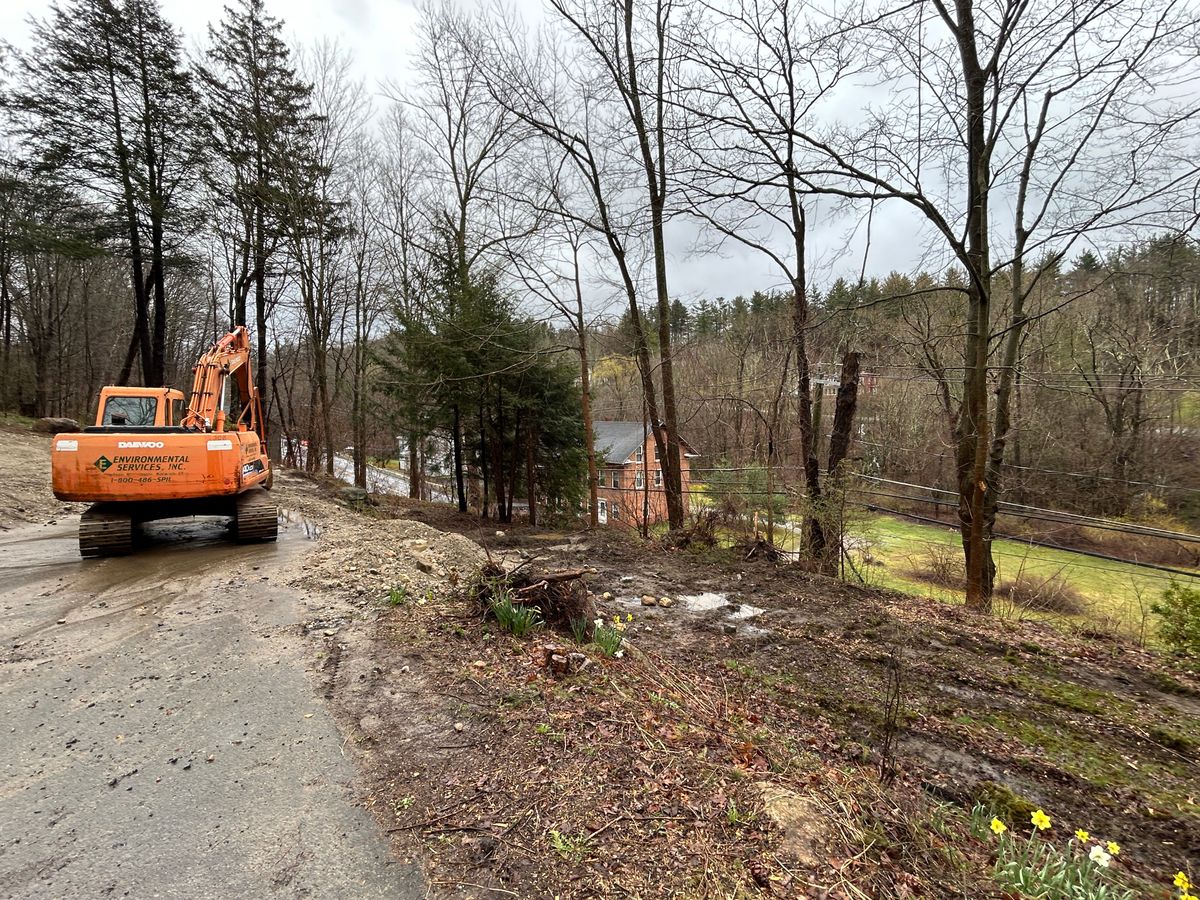Major construction begins on Route 44 in Norfolk

Slope being cleared of trees at the junction of Route 44 and Old Colony Road in Norfolk as part of CT DOT Project 97-95
Jennifer Almquist

Slope being cleared of trees at the junction of Route 44 and Old Colony Road in Norfolk as part of CT DOT Project 97-95
NORFOLK — For the next five years, travel on Route 44 will be reduced to one lane in Norfolk, also known as Greenwoods Road West, for the Connecticut Department of Transportation (DOT) to replace existing retaining walls and stabilize the slope along the north side of the road for the safety of the highway.
Last week, DOT Project 97-95, as the extensive undertaking is called, was green lit to begin. Over time the stone retaining walls along the roadway have bulged from the pressure exerted by the angle of the slope and years of heavy rains. In 2010 a mudslide occurred in the affected section of highway which extends from just west of Memorial Green to east of Old Colony Road. In 2019 DOT installed temporary concrete bin blocks, or Mafia barriers (so-called because cement production of them used to be controlled by the mob), along the base of the existing walls due to their movement.
Amy Hare, head engineer for Project 97-95, emphasized the level of preliminary work necessary. Already one family has had to relocate, and their hillside home was just razed. Currently, the town’s water company, Aquarion, is analyzing and relocation of underground water pipes from that section of highway.
Next, Eversource will remove and reconfigure all affected utility poles. Many trees need to be cleared on the slope and on Old Colony Road. The entire site was surveyed. To stabilize the slope during excavation, timber lagging (involves wiring series of wooden slats together to form a blanket) followed by soil anchors will be driven into the hillside to create a supporting wall. Mechanically stabilized earth (MSE) held by metal straps will also be used. Stones removed from the old walls will be available for use by the Town of Norfolk.
The Renkert family, who lost their home, said that they were approached 10 years ago by the state about the need for this construction project. They were sad to leave Norfolk after having raised their children in that home for 19 years and having put considerable work into its renovation.
Mrs. Renkert noted that “the guys from the state were compassionate — really terrific — businesslike, responsive and professional.” The Renkerts say that they were fairly compensated by the state and are comfortable in their new home.
While many adjacent areas will be affected by the construction, DOT is exercising caution to avoid disrupting the cemetery on Old Colony Road. Established in 1757, Norfolk’s historic Center Cemetery is located on the ridge above the unstable slope. Care has been taken to ensure that the integrity of the sacred space will not be violated. Working closely with cemetery officials, project planners established strict protocols to protect the graves and historic markers. Work vehicles entering the cemetery must fit between the two stone gate markers. Radar will be used to establish gravesites. Vulnerable areas will be clearly marked, and a temporary alternate access road will be built. All work will stop when there is a funeral. During the construction process, the public will continue to have access to all burial areas.
Traffic flow on Route 44 is already feeling the impact of the work. One lane will always be kept open wide enough for trucks to pass. An alternate 45-minute detour truck route was devised to move traffic south on 272 (near the Norfolk Library), to Route 4 to Goshen, to Route 63, then looping back up Route 7 to Canaan. Large interstate truckers can either use the suggested detour or go north to use the Mass Pike. For the smaller, local trucking companies the impact will be more severe. Delays that cut down the number of daily runs they can drive will affect their bottom line, according to the folks at George’s Garage in Norfolk. It is too early to fully predict the degree to which travel will be affected. Temporary illumination will be in place for night traffic.
When Project 97-95 is complete, the map area designated as Site #1 will have a retaining wall 1,030-feet-long, 30 to 42-feet-tall, with decorative fencing along the top. Site #2 will have a retaining wall approximately 490 feet long and will be 6-19 feet tall. The current steep slope of 1:1 (45 degrees) will be reduced to 2:1 (27 degrees). The multiple drainage systems along Route 44 that discharge directly into Blackberry River will be reconstructed and consolidated.
The improved highway will have 12-foot-wide lanes. Carving back the banks for the walls will create a wider roadway. Existing narrow shoulders will be widened to five feet allowing for a safer bicycle route. Route 44 is part of the statewide bicycling network.
The retaining walls will be made of segmented pre-cast concrete panels with an architectural “natural stone” finish to be selected by the town of Norfolk. Turf replacement using conservation grass seeds, and small plantings (to retain sightlines) will be established, following environmental and native-species guidelines.
The estimated cost of Project 97-95 is $24 million, with 80% coming from federal funds, and 20% from state funds. While Norfolk will not have to pay directly for the project, the indirect cost and inconvenience will be significant.
Norfolk First Selectman Matt Riiska acknowledged both the cost and the need, “This project has been discussed for a long time. The amount of planning and coordination has been the Department of Transportation’s focus for many years. We have neglected our infrastructure for far too long. Unfortunately, it is going to be another disruptive project for the residents in Norfolk, but these things must be done.”
Salvatore Aresco is the Project Manager for CT DOT Project 97-95.
The Salisbury Winter Sports Association (SWSA) will host its annual Junior Jump Camp, a two-day introduction to ski jumping, on Saturday and Sunday, Dec. 27 and 28, from 9 a.m. to 2 p.m. at Satre Hill in Salisbury.
The camp is open to children ages 7 and up and focuses on teaching the basics of ski jumping, with an emphasis on safety, balance and control, using SWSA’s smallest hill. No prior experience is required.
The cost is $50 per child and includes instruction and lunch on both days. For more information or to register, visit www.skireg.com/swsa-camp or email info@jumpfest.org
Jesse Bunce, first selectman of North Canaan.
LITCHFIELD — The Northwest Hills Council of Governments welcomed six newly elected municipal leaders Thursday, Dec. 11, at its first meeting following the 2025 municipal elections.
The council — a regional planning body representing 21 towns in northwest Connecticut — coordinates transportation, emergency planning, housing, economic development and other shared municipal services.
Barkhamsted First Selectman Meaghan Cook, Goshen First Selectman Seth Breakell, Kent First Selectman Eric Epstein, Norfolk First Selectman Henry Tirrell, North Canaan First Selectman Jesse Bunce and Torrington Mayor Molly Spino were each elected to their post in November.
They filled the seats of their predecessors on the COG, who were each given a toast of appreciation: Nick Lukiwsky (Barkhamsted), Todd Carusillo (Goshen), Marty Lindenmeyer (Kent), Matt Riiska (Norfolk), Brian Ohler (North Canaan) and Elinor Carbone (Torrington).
COG Executive Director Rob Phillips said the outgoing members were given a going away mug that read “You’re living the dream still.” Members voted to appoint Warren First Selectman Greg LaCava to fill a vacancy on the Council’s Executive Committee. COG members voted by paper ballot, and LaCava defeated Burlington First Selectman Doug Thompson for the vacant seat.
Ryan Segalla takes a fadeaway shot over a defender.
FALLS VILLAGE — Housatonic Valley Regional High School’s boys basketball team defeated Pine Plains High School 60-22 in a scrimmage Tuesday, Dec. 9. The non-league preseason game gave both sides an opportunity to run the court ahead of the 2025-26 varsity season.
HVRHS’s senior-heavy roster played with power and poise. The boys pulled ahead early and kept their foot on the gas through to the end.
By halftime the score was 33-8. Junior varsity players subbed in for the second half, but not before the starters got some in-game dunk practice. By the end Housatonic totaled 60 points to Pine Plains’ 22.

Nick Crodelle led the Mountaineers offensively with 13 points. Anthony Labbadia and Wyatt Bayer scored nine points each. Anthony Foley scored eight points. Owen Riemer and Ryan Segalla each scored seven points. Peyton Bushnell hit a three-pointer. Jaxon Visockis and Henry Berry each scored two points.
HVRHS begins Berkshire League competition on the road at Nonnewaug High School Tuesday, Dec. 16, with a 6 p.m. tip off.


Katie Moore delivers toys to the Stuff a Truck campaign held by the Kent Volunteer Fire Department last weekend. Donated toys are collected so that parents, who need some assistance, may provide their children with gifts this Christmas. Accepting the donation are elves Fran Goodsell and Karen Iannucci
KENT — Santa’s elves were toasty warm as they collected toys for the children of Kent.
Keeping with annual tradition, Fran Goodsell and Karen Iannucci manned the Stuff a Truck campaign sponsored by the Kent Volunteer Fire Department on Saturday, Dec. 6, and Sunday, Dec. 7. Sitting in front of a fire pit in the firehouse parking lot between donations from residents, they spoke of the incredible generosity displayed every season. That spirit of giving was clear from the piles of toys heaped on a table.
“This is always so gratifying,” said Goodsell, noting that certain businesses, including High Watch Recovery Center, Wilson’s, and Kent and South Kent schools needed a “shout out” for all they’ve done. She said South Kent School focuses on gifts for older children, which is a group that often is overlooked.
Unwrapped contributions are sought for children 1 to 15 years old who might otherwise find little or nothing from Santa, they said. The bounty will be set up at the Community House on Thursday, allowing parents to come and take what they want. If there are still items left, grandparents are invited to “shop.”
The atmosphere was festive Saturday, as a stuffed dog began barking a Christmas tune whenever someone walked in front of it. A large decked-out bear posted at the parking lot entrance reminded passersby of the event. Visiting children were able to get a close-up look at the fire truck and walk through the firehouse if they wished.
Goodsell and Iannucci were very grateful to those who donated wood for the fire pit. “And so many asked if they could bring us coffee or hot chocolate,” said Iannucci.
Goodsell said many who came talked about having grown children who were recipients of the gifts when their families were struggling. “They are so glad to be able to give back,” she said.